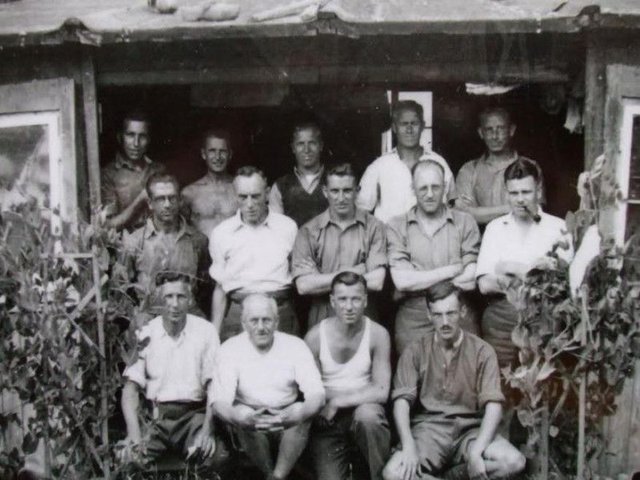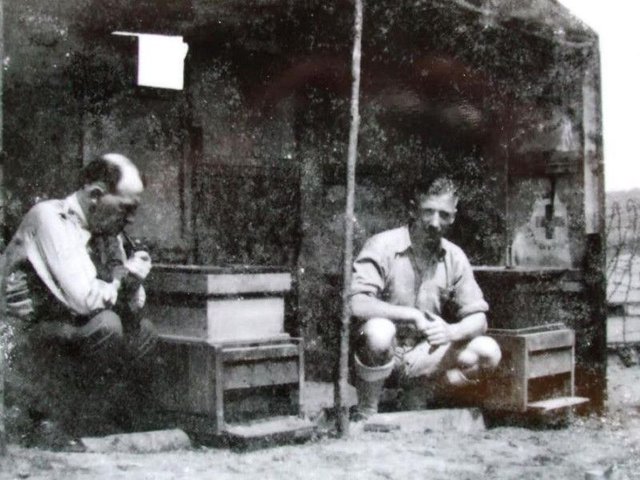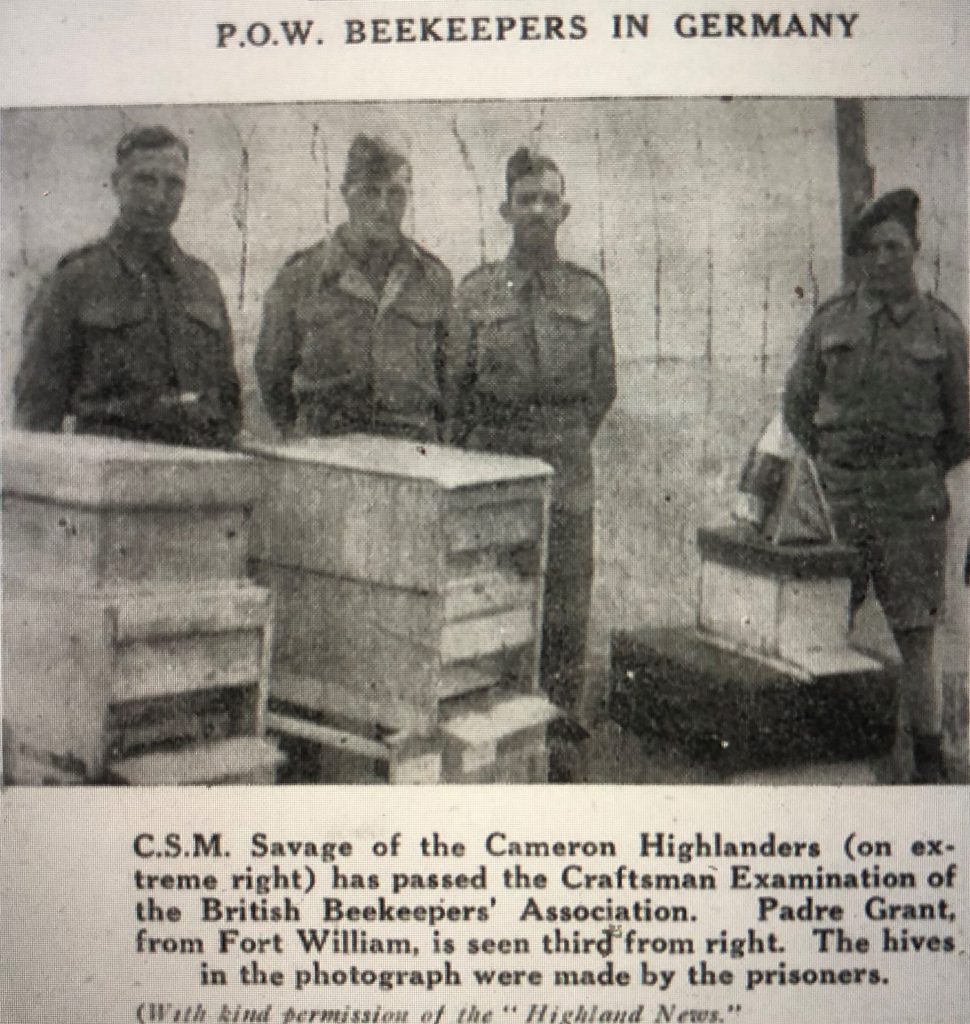
This week’s guest blog by (Hugh) Taylor Hood is a fascinating account of an innovative Scottish beekeeper who set up an apiary behind barbed wire in a German WW2 prison camp.
Taylor is a fourth generation beekeeper, and has been keeping bees since he retired in 2012 although he has had an interest in bees all his life.
Taylor is Past President of Glasgow and District BKA, Lanarkshire BKA and Clyde Area Beekeepers’ Association.
He is better known for his articles in working a Stewarton Hive, and queen rearing along with editing the writings of Ian Craig MBE, Charles Irwin MBE and Eric McArthur MBE in the wonderful Book the Glasgow Beekeepers.
James Savage.

Following his retiral, James Savage NDB lived in Inverness for almost 20 years, dying in 1985.
James Savage was a Tarbolton boy from Ayrshire who learned his beekeeping skills from his father who kept bees. James was well known in beekeeping Associations throughout Scotland, particularly the South West where he was employed at Auchincruive, West of Scotland Agricultural College, initially as a lecturer of Beekeeping and then Head of Beekeeping till he retired in August 1966.
During his time at Auchincruive he gained a National Diploma in Beekeeping, wrote articles for the Scottish Beekeeper and gave numerous bee talks/ lectures to Beekeeping Associations. Nothing out of the ordinary you may think.
However, James Savage was no ordinary beekeeper.

In 1922 James joined the Cameron Highlanders, being awarded the Military Medal for bravery in Palestine in the 1930’s, and becoming a Company Sergeant Major for the regiment.
During WW2 he was captured and taken prisoner at St Valery en Caux on June 12th, 1940 when the 51st Highland Division were left behind following the Dunkirk evacuation at the end of May 1940. He endured a forced march across Europe and Poland but was sent to a Punishment Camp for Non-Commissioned Officers, Stalag 383, near Hohenfels after refusing to work in Munich clearing up bomb damaged areas.

James heard of a beekeeper who lived near Stalag 383 and managed to persuade the Kommandant to let him visit the beekeeper, who was a local farmer. The farmer agreed to lend James a colony of bees on the condition that they were returned at the end of his time at the camp. The farmer gave them all the equipment they needed to get started: a hive, frames, foundation and other equipment.

The Captive Drone Society.
The Captive Drone Society was set up at the camp and James trained many of his fellow prisoners as beekeepers.
Apparently, he set up an observation hive in the dentist’s room in the camp hospital to create a welcome distraction for the prisoners waiting to have teeth extracted.
On one occasion when a colony swarmed the whole camp turned out in force to watch. James worried that he would lose the swarm started to walk slowly through the bees, moving towards a large rock in the centre of the camp. He was hoping that the queen would follow him and try to settle near him on the rock. Fortunately, the queen and bees settled there as planned, thus adding to the myth the guards and PoWs had that James had some unseen power over the bees.

James was able to get books through the Red Cross and YMCA (Young Men’s Christian Association), and he used Red Cross crates to make hives which he later used to collect and house swarms that were collected. There is a photo in the September 1944 Scottish Beekeeper of James Savage and Captain Reverend Kenneth Grant from Fort William (Later to become a Bishop) , James passed the Craftsman Examination of the BBKA while a prisoner.

The BBKA (British Beekeeper’s Association) supported the prisoners in every way they could and this included sending out exams via the Red Cross.
The PoWs only got a little honey but most was left for the bees, along with additional sugar taken from the PoWs rations to allow the bees to survive the harsh winters.
The whole camp was fascinated by the bees, which flourished, and by the end of the war had grown to 4 colonies which, as promised, were returned to the farmer.
Keeping bees had a positive effect on the camp. It kept the PoWs busy during their time there as well as being good for their mental health.
In 1945 when the camp was being moved from Hohenfels to Landshut to avoid the advancing American and Russian Armies, James managed to escape, hiding in woods for four days before meeting up with the advancing Americans.
When he left the army after the war, James went to Auchincruive and followed a career in beekeeping, a job he dearly loved.
He retired on the 31st of August 1986 and moved to Inverness.

Further Reading:
Stalag 383 by Stephen Wynn
https://www.sruc.ac.uk/all-news/the-beekeeper-of-stalag-383/
The Scottish Beekeeper Magazine:-
September 1944 page 117
July 1945 page 94
April 1946 page 37
December 1961 page 211
October 1966 page 168 & 169
December 1966 page 201
Thank You, Taylor.
Thank you Taylor for this engaging account of a brave Scottish soldier and intrepid beekeeper. It’s another fine example of how honey bees are not just a commodity providing a monetary reward: they are an inspiration to humankind yielding much richer rewards and benefits.

Good article!
It is a good article, Iain, and I am glad you liked it. Beelistener is lucky to have so many good guest bloggers.
An amazing tale. I wonder what he did regards a veil if anything!
It is an amazing account, Stewart. I think that they probably managed without veils. If you study a lot of old beekeeping photographs, generally veils are not worn and I wonder if it is due to the sub species of bee, and pehaps the purity as fewer imports and hybridisation back then? Andrew Abrahams on Colonsay has pure Amm and I have never seen calmer and more gentle bees. Andrew usually never wears a veil. This is just my theory!
George Lochtie from Aberdour who was one of the beekeeping PoWs at Stalag 383 said that the veils used were made from (sword) fencing masks.
Hello Taylor. Thank you for that additional information which is even more astounding really. Where did the sword fencing masks come from? Surely the prisioners were not allowed to fence? Perhaps they were sent in by the Red Cross? Altogether an amazing story and thank you for piquing our curiosity. Best wishes, Ann.
Again from George Lochtie’s account he states that the fencing masks were found in a barn. I believe it is unlikely that they were found by PoWs. It is more likely the farmer found them and passed them on or it is possible that they were found by a German guard who then bartered them for ” a bit of chocolate and a few cigarettes” which the PoWs got in their Red Cross parcels.
Hello Taylor. Thank you for shedding more light on this fascinating story. Best wishes, Ann.
It is almost unbelievable, how those running the POW camp allowed James Savage to do what he did with the local beekeeper and with the bees. Maybe it was a rural location? In northern Maine, there were POW camps and some of the German POW’s married Maine girls after the war, so security must have been somewhat relaxed up there, too. Thank you for sharing this account of officer/beekeeper James Savage.
I thought so too but Taylor Hood suggests that the guards would have reduced the risks of POWs escaping if they were involved with beekeeping.